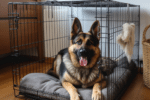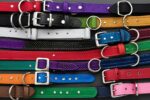Assembling a Comprehensive DIY Dog First Aid Kit
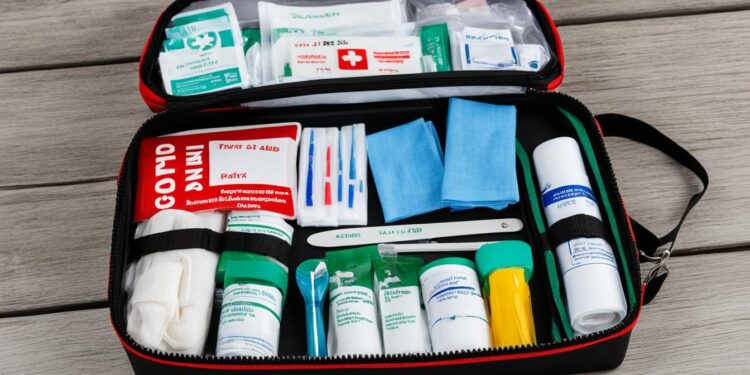
When it comes to the health and safety of your beloved four-legged friend, it’s important to be prepared for any unexpected situations. Having a dog first aid kit on hand is a crucial step in ensuring their well-being, especially when emergencies occur far from immediate help.
A comprehensive DIY dog first aid kit is a must-have for every pet owner. It should include essential items recommended by experts, such as absorbent gauze pads, tape, hydrogen peroxide, gloves, scissors, tweezers, antibiotic ointment, oral syringe, towels, flashlight, and more. By assembling your own dog first aid kit, you can tailor it to your dog’s specific needs and activities.
Regularly checking the kit for expired items and keeping it out of children’s reach is also crucial. To learn more about the importance of a dog first aid kit and the must-have items to include, continue reading.
The Importance of a Dog First Aid Kit
Accidents and unexpected events can happen at any time and anywhere, making it crucial to have a DIY dog first aid kit readily available. Whether it’s a pet emergency, unexpected injuries, or incidents like a dog fight or getting hit by a car, having essential first aid supplies for dogs can help provide immediate care and potentially save a life.
“Being prepared with a well-stocked first aid kit for your dog can make a significant difference in their outcome during an emergency,” says Dr. Emily Thompson, a veterinarian at PetCare Hospital.
Having a DIY dog first aid kit allows you to be proactive and react promptly to unforeseen circumstances. By having essential items at your disposal, you can administer initial care to your furry friend before seeking professional veterinary help. Unlike human emergencies, pet emergencies may not always occur conveniently near a veterinarian, making it paramount to have the necessary supplies on hand to stabilize your dog’s condition.
“A dog first aid kit provides the tools and resources necessary to manage minor injuries, control bleeding, and help stabilize your pet’s condition until they can be seen by a qualified veterinarian,” explains Dr. Thompson.
Preparing for the Unexpected
Having a dog first aid kit ready for unexpected events is especially important for outdoor activities like hiking or camping. In these situations, your furry friend may encounter a thorn, bite, or other injuries that require immediate attention. Similarly, having a first aid kit in your car can be lifesaving during emergencies on the road.
Your DIY dog first aid kit can be tailored to your dog’s specific needs based on their breed, age, and any existing medical conditions. For instance, a dog with a history of allergies may require additional antihistamines in their first aid kit.
“Having a well-prepared first aid kit specific to your dog’s needs can increase their chances of a quick recovery and reduce the risk of complications,” advises Dr. Thompson.
What to Include in Your Dog First Aid Kit
| Essential Items | Function |
|---|---|
| Gauze pads and rolls | For dressing wounds and controlling bleeding |
| Tape | To secure gauze and bandages |
| Scissors | To cut bandages and clothing, and remove matted fur |
| Tweezers | To remove splinters, ticks, or foreign objects |
| Antibiotic ointment | For preventing infection |
| Hydrogen peroxide | For inducing vomiting (consult a vet before using) |
| Styptic powder | To aid in clotting and stop bleeding from minor cuts |
| Wound cleaner or antiseptic rinse | To clean and disinfect wounds |
| Bottled water | For hydration and cleaning wounds |
| Cold packs | To reduce swelling and inflammation |
| Emergency contact information | Vet contact details and local emergency clinics |
| Basic medications | Antihistamines, anti-diarrheal, and pain relievers |
| Extra leash and collar | In case of emergencies or lost collars |
| Source: Dr. Emily Thompson, PetCare Hospital. |
Must-Have Items for a DIY Dog First Aid Kit
When it comes to the well-being of our furry friends, being prepared is key. A DIY dog first aid kit is an essential tool that every pet owner should have to handle minor injuries, provide wound care, and ensure the safety of their beloved pets. Stocked with the right supplies, this kit can help you address emergencies promptly and effectively.
Essential Dog First Aid Items
Here are some essential items that should be included in your DIY dog first aid kit:
- Documentation: Keep important documents such as your veterinarian’s contact information and your dog’s vaccination records.
- Towels or blankets: These can be used for various purposes, such as creating a clean space for examination or providing warmth and comfort.
- Bandages: Include a variety of bandages, such as self-adhesive wraps and gauze pads, to help manage wounds and control bleeding.
- Tools: Pack a pair of scissors and tweezers to aid in wound care and removing foreign objects.
- Hydrogen peroxide: This can be used to induce vomiting in case of accidental poisoning, but only under the guidance of a veterinarian.
- Wound cleaner or antiseptic rinse: These solutions help clean wounds and reduce the risk of infection.
- Antibiotic ointment: Apply antibiotic ointment to minor cuts and scrapes to promote healing and prevent infection.
- Styptic powder: This powder helps stop bleeding from minor cuts or broken nails.
- Bottled water: Keeping a supply of clean water ensures hydration in case of emergencies.
- Wet wipes: These are handy for cleaning your dog’s paws, ears, and other areas as needed.
- Cold packs: Use cold packs to reduce inflammation and provide relief from pain and swelling.
In addition to these essential items, it’s highly recommended to include a comprehensive first aid guide. This guide will provide instructions on how to administer basic first aid and handle common emergencies effectively. It’s essential to familiarize yourself with the instructions before an emergency occurs, ensuring you’re well-prepared to provide the necessary care.
Remember, the key to effective first aid is quick action and preparedness. By having a well-stocked DIY dog first aid kit, you can ensure the safety and well-being of your furry companion in times of need.
| Essential Dog First Aid Items | Benefits |
|---|---|
| Documentation (vet contact information, vaccination records) | Quick access to important information during emergencies |
| Towels or blankets | Provide comfort and warmth, create a clean space for examination |
| Bandages (self-adhesive wraps, gauze pads) | Manage wounds, control bleeding |
| Tools (scissors, tweezers) | Aid in wound care, remove foreign objects |
| Hydrogen peroxide | Induce vomiting in case of accidental poisoning (under veterinary guidance) |
| Wound cleaner or antiseptic rinse | Clean wounds, reduce infection risk |
| Antibiotic ointment | Promote wound healing, prevent infection |
| Styptic powder | Stop bleeding from cuts or broken nails |
| Bottled water | Ensure hydration during emergencies |
| Wet wipes | Clean paws, ears, and other areas |
| Cold packs | Reduce inflammation, provide pain relief |
Having these essential items in your dog first aid kit will help you be better prepared to handle minor injuries, promote wound care, and ensure the safety of your pet. Remember to regularly check the kit for expired items and restock as needed.
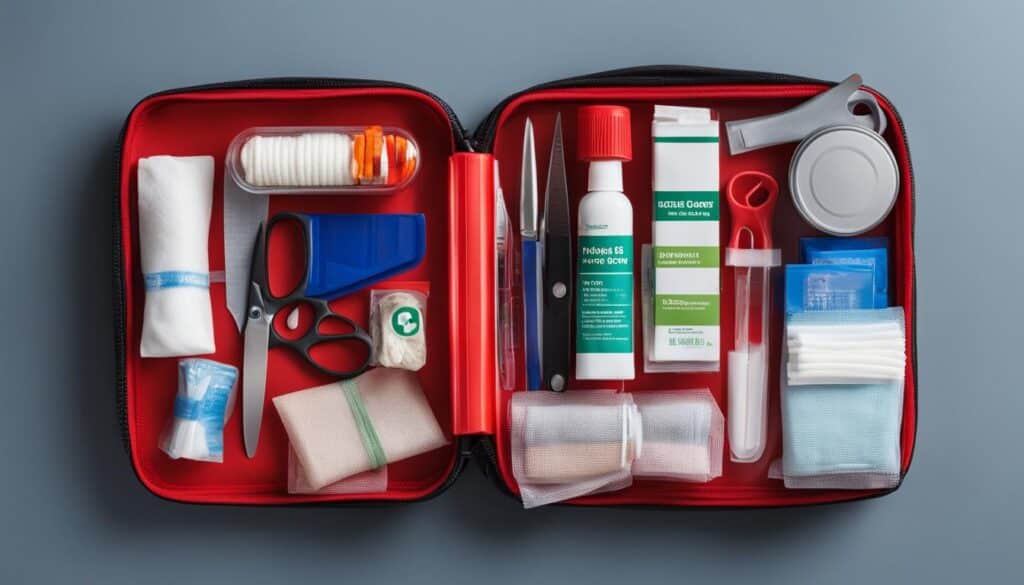
Tips for Assembling Your Own Dog First Aid Kit
As a responsible pet owner, assembling your own DIY dog first aid kit is a highly recommended step towards ensuring the safety and well-being of your furry friend. By customizing the kit based on your dog’s specific needs and activities, you can be fully prepared for any unforeseen emergencies. Here are some essential tips to help you assemble a comprehensive dog first aid kit:
- Start with the essentials: Begin by including must-have items that form the foundation of your dog first aid kit. These items include emergency phone numbers, identification information for your pet, medical records, and a recent photograph of your dog. These details can greatly assist veterinary professionals in providing prompt and accurate care.
- Wound care supplies: Accidents happen, and it’s important to be prepared for minor injuries. Include items like gauze pads and rolls, adhesive tape, and sterile saline solution for cleaning wounds. This will help you effectively manage and care for any cuts, scrapes, or abrasions.
- Safety and diagnostic tools: It’s crucial to have the right tools for assessing your dog’s health condition. Include scissors, a digital thermometer, and an oral syringe for administering liquids or medications. Additionally, pack a pair of gloves to protect yourself and prevent the spread of any potential infections.
- Medications and treatments: Consult with your veterinarian to determine the medications and treatments suitable for your dog’s specific needs. Stock up on essential items such as antibiotic ointment, styptic powder for addressing bleeding nails, and antihistamines for allergic reactions.
- Emergency supplies: In case of extreme weather conditions or prolonged emergencies, it’s essential to have emergency supplies on hand. Include items like emergency thermal blankets, extra leashes and collars, dog booties or small socks to protect their paws, a soft muzzle, collapsible bowl for water, and energy-boosting sugar packets or honey for low blood sugar.
Remember, a well-organized dog first aid kit should be easily accessible and regularly checked for expired items. By following these tips and including the necessary items, you can enhance your emergency preparedness and ensure the health and safety of your beloved canine companion.
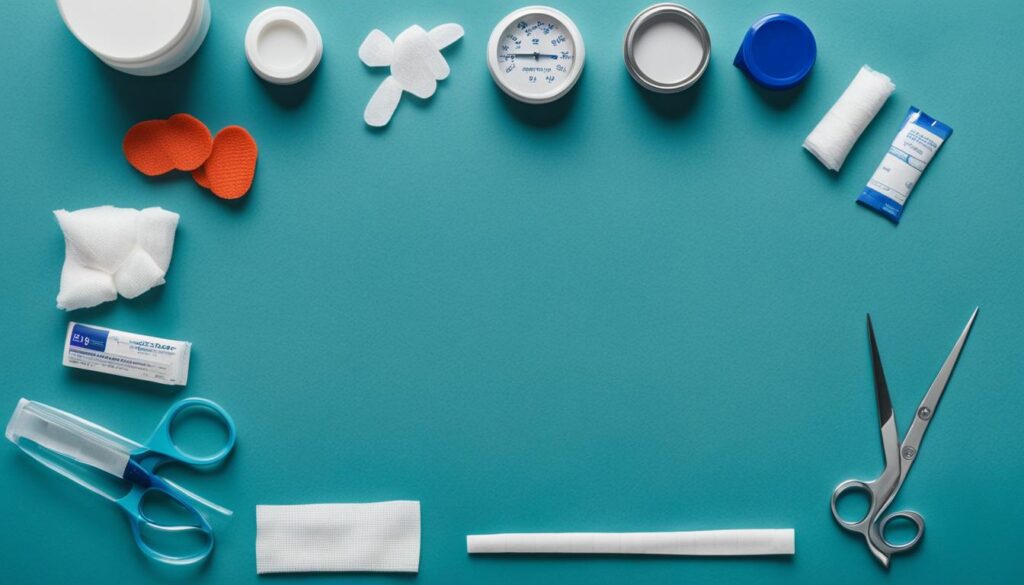
Essential Items for a DIY Dog First Aid Kit
| Category | Items |
|---|---|
| Emergency Contact | Phone numbers for the veterinarian, animal poison control, and local animal emergency clinic |
| Identification | Collar with ID tag and microchip information, recent photograph of your dog |
| Medical Records | Vaccination records, any medical conditions or allergies |
| Wound Care | Gauze pads and rolls, adhesive tape, sterile saline solution |
| Tools | Scissors, digital thermometer, oral syringe, gloves |
| Medications and Treatments | Antibiotic ointment, styptic powder, antihistamines |
| Emergency Supplies | Emergency thermal blankets, extra leashes and collars, dog booties or small socks, soft muzzle, collapsible bowl, sugar packets or honey |
Importance of Being Prepared with a Dog First Aid Kit
Being prepared with a well-stocked dog first aid kit is crucial for ensuring the safety and well-being of your pet in case of an emergency. Accidents and injuries can happen unexpectedly, and having the necessary supplies readily available can make a significant difference in your dog’s outcome.
With a DIY dog first aid kit, you can quickly address minor injuries, manage wounds, and stabilize your dog’s condition until professional veterinary help can be accessed. This level of preparedness can help minimize the impact of an emergency and provide immediate care to your furry companion when they need it the most.
Safety Measures for Emergency Preparedness
Incorporating safety measures into your emergency preparedness plan is essential for ensuring the best possible outcomes. Here are some key measures to consider:
- Regularly check and replenish your dog first aid kit to ensure that it is stocked with fresh and unexpired supplies.
- Keep your dog first aid kit in a designated and easily accessible location, known to all family members.
- Ensure that all family members are familiar with the contents of the kit and know how to use them effectively.
- Consider attending a pet first aid and CPR training course to enhance your knowledge and skills in emergency situations.
- Keep emergency contact information, including your veterinarian’s phone number and the nearest emergency veterinary clinic, easily accessible.
- Create a pet emergency plan that includes designated meeting points, nearby pet-friendly accommodations, and transportation arrangements.
- Regularly practice and review your emergency plan with your family members to ensure everyone is prepared and knows their roles and responsibilities.
Pet Health and Safety Tips
Aside from having a well-stocked dog first aid kit, there are other measures you can take to prioritize your pet’s health and safety:
- Ensure that your dog has proper identification, such as a collar with identification tags and a microchip, to help reunite you with your pet in case they become lost.
- Keep your dog’s vaccinations up to date to protect them from preventable diseases.
- Regularly groom your dog to maintain their hygiene and detect any signs of skin issues, ticks, or fleas.
- Provide a safe and secure environment for your dog, both indoors and outdoors, to prevent accidents or injuries.
- Give your dog regular exercise and mental stimulation to promote their overall well-being.
- Keep potentially toxic substances, such as cleaning products, medications, and certain plants, securely stored and out of reach of your dog.
- Monitor your dog’s behavior and health regularly and seek veterinary attention if you notice any concerning symptoms or changes.
By incorporating these safety measures and being prepared with a dog first aid kit, you can ensure the best possible care for your pet during emergencies and prioritize their health and safety.
| Emergency Preparedness | Safety Measures | Pet Health and Safety |
|---|---|---|
| Being prepared | Regularly check and replenish your dog first aid kit | Ensure proper identification for your dog |
| Having necessary supplies | Keep your dog first aid kit in an accessible location | Keep vaccinations up to date |
| Minimizing impact | Create a pet emergency plan | Regular grooming and health monitoring |
Conclusion
Assembling a comprehensive DIY dog first aid kit is an essential step for every pet owner to ensure the health and safety of their furry companion in case of an emergency. By including essential items such as gauze pads, tape, hydrogen peroxide, scissors, antibiotic ointment, and more, you can be prepared to handle various situations and provide immediate care to your dog.
Regularly checking your kit for expired items and keeping it easily accessible will ensure the best possible outcome in case of an emergency. Remember to review the kit regularly to ensure all supplies are up-to-date and in good condition.
Having a well-stocked dog first aid kit is not only a demonstration of DIY safety but also a crucial element of emergency preparedness. By being proactive and prepared, you can give your furry friend the care they need in those unexpected moments when professional help may not be readily available. So, don’t wait until it’s too late. Start assembling your DIY dog first aid kit today to give yourself peace of mind and protect the well-being of your beloved pet.
FAQ
Why is a dog first aid kit important?
A dog first aid kit is important because it allows pet owners to provide immediate care in case of an emergency or accident. Having essential supplies readily available can potentially save a dog’s life and prevent further complications.
What items should be included in a DIY dog first aid kit?
Some essential items to include in a DIY dog first aid kit are absorbent gauze pads, tape, hydrogen peroxide, gloves, scissors, tweezers, antibiotic ointment, oral syringe, towels, flashlight, and more. It’s important to customize the kit based on your dog’s needs and activities.
How often should I check my dog first aid kit for expired items?
It is recommended to regularly check your dog first aid kit for expired items. This could be done every six months or whenever you change your pet’s medication or supplies. Keeping the kit up-to-date ensures that the items will be effective when needed.
How can I tailor my DIY dog first aid kit to my dog’s needs?
To tailor your DIY dog first aid kit to your dog’s needs, start with essential items and gradually add to your kit. Consider your dog’s specific activities, such as hiking or car travel, and include items that would be beneficial in those situations.
How do I ensure easy accessibility of my dog first aid kit?
To ensure easy accessibility of your dog first aid kit, keep it in a designated and easily reachable location in your house. Make sure all family members are aware of the kit’s location and keep it away from children to prevent accidental ingestion of medications or supplies.




